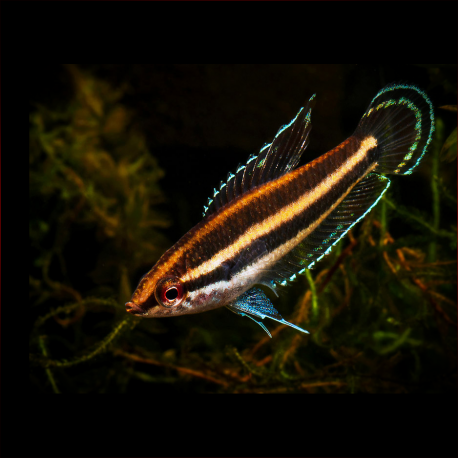More info
Datasheet
| Minimum Tank Size | 25 litres / 6.60 US gallons |
| Maximum Size | 4.0cm / 1.57inches |
| Temperature | 22°C / 71.60°F - 28°C / 82.40°F |
| Hardness | 1.01dgH / 18ppm - 4.03dgH / 72ppm |
| pH | 3.0-6.5 |
General Description
Parosphromenus deissneri, also known as Deissner's Liquorice Gourami, is a small micropredatory fish belonging to the Perciformes order. It has been misapplied in the aquarium and ichthyological literature due to its rarity in the hobby and difficulty in identification.
Aquarium Setup
Maintaining P. deissneri in a fully-decorated aquarium with driftwood, roots, and branches can provide shady spots and shelter. Dried leaf litter can be added for a natural feel and as a food source. Soft water with acidic conditions and dim lighting are essential, with aquatic plants like Microsorum and floating vegetation recommended. Filtration should be gentle, and regular water changes are necessary due to their sensitivity to organic wastes.
Behaviour
These fish are not recommended for a general community aquarium due to their specific care requirements, conservation status, and disposition. It is advised to keep them alone or with peaceful cyprinids like Boraras or Sundadanio species. Maintaining mixed-gender groups is possible, but breeders often prefer sexed pairs to enhance breeding success.
Feeding and Diet
As micropredators, P. deissneri feeds on tiny aquatic invertebrates. In the aquarium, they should be offered small live foods like Artemia nauplii, Daphnia, and mosquito larvae. Frozen foods are sometimes accepted, but dried products are typically refused due to insufficient nutrition.
Reproduction & Dimorphism
These fish form temporary pair bonds during spawning, with males taking sole responsibility for egg and brood care. Males exhibit a more intense color pattern than females, with distinct markings on their fins. Females are less colorful and can change color depending on mood.
Habitat and Distribution
Endemic to the island of Bangka in Indonesia, P. deissneri is found in jungle swamps and streams with slowly-moving, tea-colored water. Unfortunately, they now survive in remnants of heavily-modified peat swamp habitats. The dissolved mineral content is generally low, with a pH as low as 3.0 to 4.0.

